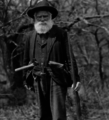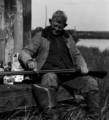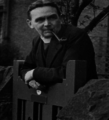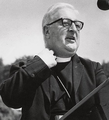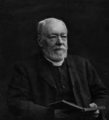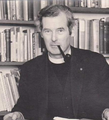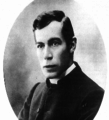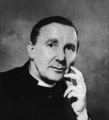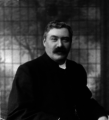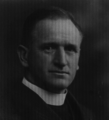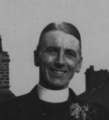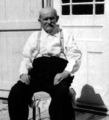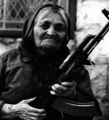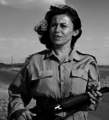Church of the Holy Lance: Difference between revisions
(Holy Lance no longer official in Jaaland) |
No edit summary |
||
| (2 intermediate revisions by 2 users not shown) | |||
| Line 1: | Line 1: | ||
[[File:CotHL_Logo.png|200px|thumb|Logo of the Church of the Holy Lance]] | [[File:CotHL_Logo.png|200px|thumb|Logo of the Church of the Holy Lance]] | ||
The '''Church of the Holy Lance''' | The '''Church of the Holy Lance''' was the state church of [[Floria]]. The religion originated from [[Nova England]] in the late 1650s. The Guardian of the Lance is the most senior cleric (Currently ''TBC''). It traces its history to the early churches established during the conversion of the Faedertellus from Nova English Paganism to the [[Nazarene]] faith. | ||
The governing structure of the church is based on ‘laeths’, each presided over by a Lance Bearer. Within each laeth are local hides. The governing body of the church is known as the council of laeths and is formed by both Lance Bearers and laypeople selected by lottery to attend gatherings. The Church also featured a militant wing in the form of the [[Brotherhood of The Holy Lance]], which was tasked with the defence of the church, and its followers across the globe. This was replaced by a volunteer wing of soldiers from the [[Confederate States Armed Forces]] in the {{AN|1700}}s. In 1707 the religion started to decline as the followers of the religion converted to the [[Church of Floria]], a branch of the religion more suitable to the population of Floria. | The governing structure of the church is based on ‘laeths’, each presided over by a Lance Bearer. Within each laeth are local hides. The governing body of the church is known as the council of laeths and is formed by both Lance Bearers and laypeople selected by lottery to attend gatherings. The Church also featured a militant wing in the form of the [[Brotherhood of The Holy Lance]], which was tasked with the defence of the church, and its followers across the globe. This was replaced by a volunteer wing of soldiers from the [[Confederate States Armed Forces]] in the {{AN|1700}}s. In 1707 the religion started to decline as the followers of the religion converted to the [[Church of Floria]], a branch of the religion more suitable to the population of Floria. | ||
The church remains extant in [[Moorland]], the [[South Sea Islands]], and the [[Warring Islands Special Autonomous Region]]. | |||
==Doctrine & Practice== | ==Doctrine & Practice== | ||
| Line 135: | Line 137: | ||
[[Category: Nova England]][[Category: Religion]][[Category:Jääland]] | [[Category: Nova England]][[Category: Religion]][[Category:Jääland]] | ||
[[Category:Nazarene]] | |||
Latest revision as of 14:56, 4 December 2024
The Church of the Holy Lance was the state church of Floria. The religion originated from Nova England in the late 1650s. The Guardian of the Lance is the most senior cleric (Currently TBC). It traces its history to the early churches established during the conversion of the Faedertellus from Nova English Paganism to the Nazarene faith.
The governing structure of the church is based on ‘laeths’, each presided over by a Lance Bearer. Within each laeth are local hides. The governing body of the church is known as the council of laeths and is formed by both Lance Bearers and laypeople selected by lottery to attend gatherings. The Church also featured a militant wing in the form of the Brotherhood of The Holy Lance, which was tasked with the defence of the church, and its followers across the globe. This was replaced by a volunteer wing of soldiers from the Confederate States Armed Forces in the 1700 ANs. In 1707 the religion started to decline as the followers of the religion converted to the Church of Floria, a branch of the religion more suitable to the population of Floria.
The church remains extant in Moorland, the South Sea Islands, and the Warring Islands Special Autonomous Region.
Doctrine & Practice
The canon law of the Church of the Holy Lance identifies the Nazarene scriptures and the Book of The Holy Lance as the sources of its doctrine. Much of the teachings and outlooks of the church are heavily influenced by early Nova English proto-religions and the reverence of martial prowess.
Worship & Practice
Churches and other places of worship generally only feature regular services on Sundays and religious holidays. Outside of these regular services, followers are able to attend their place of worship to pray, study or speak with the priest. Services will usually feature readings of the Bible or Book of the Holy Lance, hymns, prayer and homilies.
Example of a typical service
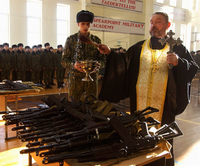
Presiding priest will stand before the faithful and welcome them.
The Lord's Prayer. Our Father, who art in heaven, Hallowed be thy Name. Thy kingdom come. Thy will be done, On Micras as it is in heaven. Give us this day our strength. And protect our kinsfolk, As we smite those who trespass against you. And lead us not into weakness, But deliver us from conflict. For thine is the kingdom, and the power, and the glory, for ever and ever. Amen
Priest will give news of upcoming baptisms, weddings and any religious holidays.
Hymn.
Priest will take the church’s lance and lay it on the alter, as they do so they state the following blessing;
Hallowed be this weapon, our representation of the Holy Lance. May the Lord bless it with his strength as we carry out his will upon Micras.
They will then scatter some holy water upon the spear, before inviting the congregation to present their own weapons for blessing.
Hymn.
Reading from the Book of the Holy Lance or the Bible.
The Pledge (Prayer) Lord Almighty. Blessed are we your faithful soldiers. May our spears stay sharp and our shield walls unbreakable, As we defend your honour and truth. May our strength and dedication be unwavering, As we face the trials ahead. May our martyrdom and selflessness be awe-inspiring, As we battle the daemons of this world. Forever we pledge our allegiance as your warriors on Micras. Amen.
The priest will then return the spear to its rest and bless the congregation; Hallowed are we the soldiers of God, the chosen who have been given the mission of enacting his will upon this world.
The priest will then dismiss the congregation.
Membership
Membership of the Church of the Holy Lance was believed to be at 1.4 Million baptised followers spread throughout Mercurian Nova England and the Kingdom of Nova England. Following the collapse of the Kingdom in 922AJ and the integration of New Sussex into the Republic of Mercury, membership declined from 2 million followers to around 700,000 practicing members. However following the re-emergence of the Faedertellus and its ongoing territorial expansions, this number rapidly increased.
Somewhat improbably, mostly as a consequence of time spent in various gaols awaiting exchange on a truce day or execution, the Church of the Holy Lance had built up a surprisingly strong following in the ranks of the Sea-Reavers, a Shirerithian naval auxiliary that degenerated into outright piracy in the waters of the Great Western Ocean during the 980s and which consequently spent an inordinate amount of its existence locked in combat with the armed forces of Nova England.
In 995AJ the Church expanded into the Republic of Floria, marking the first official expansion of the church into non-Britannic territories and the religion rapidly expanded. Today Floria is the last remaining dominion of the religion after the dissolution of Nova England and has a number of over 62 million followers.
Structure
The Church is structured as follows;
- Hide: A Hide is the most local level of the church, generally featuring one church building and community. It is run by the Hide Priest who organises and leads services and other functions within their appointed Hide.
- Laeth': A Laeth refers to a grouping of Hides, usually based on the structure of existing regional boundaries. These are presided by a Lance Bearer who is selected by the Hide Priests every three years. The role of the Lance Bearer is to ensure order within their Laeth through regular meetings and represent their Laeth at the Council of Laeths.
- Council of Laeths: The Council of Laeths represents the legislative and overall governing body of the Church of the Holy Lance. Consisting of Lance Bearers representing their Laeths and an equal number of church goers chosen at random by lottery to attend individual council gatherings. The Guardian of the Lance acts as the presiding officer of the Church and the council but may only vote on matters where a vote has been tied.
Priesthood

Unlike some Nazarene denominations, all offices of worship within the Church of the Holy Lance are open to both genders on the basis that all those capable of enduring the Trials of the Lance are selected by God. Aspiring priests begin their service at the College of St John in West Grinstead, where they are provided the teachings of the church. After which they are required to participate in the trials of the lance to become a shadow to a Hide Priest in their appointed Hide. All appointed priests are permitted to marry and have children.
The Trials of the Lance are a series of tests created to prove that the aspiring priest has the approval and backing of God in their chosen profession. Those that fail are unable to pursue priesthood but are sometimes able to find other positions within the church. The trials consist of;
- Trial by Combat; Two priests armed with wooden staffs fight until one is either knocked unconscious or surrenders.
- Trial by Truth; The aspiring priest is asked questions about the Book of the Holy Lance and must recall these correctly.
- Trial by Endurance; This trial requires the aspiring priest to survive with no outside help in a secluded wilderness location for a period of three days.
- Trial by Temptation; The aspiring priest will be offered a bribe or other vices, which they must resist.
- Trial by Judgement; A panel of priests from the college, judge the performance of the aspiring priest during their schooling at the college.
- Trial by Fire; Like the metal blade of the Holy Lance, the aspiring priest must be baptised in fire. They are required to walk over burning coals, before being branded on their left arm with the mark of the church. Before finally being baptised in water which represents the quenching of the metal. The mark itself signifies that no priest can hide their identity as a chosen voice and teacher of God.
Senior Church Figures
- CotHL priest18.png
Lance Bearer Mark Fyr of Floria


